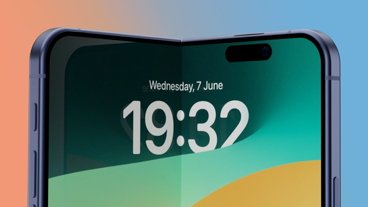Representatives for the Sunnyvale, Calif.-based AMD have recently been seen on Apple's Commuter Coach buses, and executives for the chipmaker have been spotted on their way out of meetings with members of Apple's top brass, according to people familiar with the matter.
The meetings have reportedly included briefings by AMD that have since enabled Apple to begin working with AMD processors in its labs as part of an initiative to position the chips inside some of the company's forthcoming products. While AMD offers a variety of embedded processors, Apple is believed to be investigating the chipmaker's workstation and notebook class CPUs.
It is believed that Apple is working with AMD to expand its potential sources for CPUs in order to increase its flexibility and broaden its competitive options, but also likely in response to problems it has encountered with Intel. These issues include limited availability of new processors (which is rumored to have slowed Apple's notebook refreshes) as well as new chipset designs imposed by Intel that have blocked the Mac maker's plans to continue a partnership with NVidia to deliver a standardized chipset for use with its Intel processors across all of its consumer computer offerings.
Intel has fought against Nvidia to close the market for alternative chipsets for use with its CPUs, which resulted this week in Apple being forced to use Intel's own limited integrated graphics chips inside its new MacBook Pros instead of using more capable parts from Nvidia.
Why Apple hasn't used AMD CPUs before
When Apple first announced its plans to migrate to Intel CPUs back in 2005, many observers questioned why the company wasn't also using AMD's compatible processors as a secondary option. AMD's chips at the time were considered more powerful and often cheaper than Intel's flagship offerings, including the Pentium IV. However, Apple was privy to information about Intel's roadmap, and was primarily interested in the company's new Core line of fast, yet energy efficient designs suitable for use in its notebooks.
AMD's edge in CPUs in the first half of the 2000 was blown away by Intel's new Core family, which came to market just as Apple was making its transition. AMD currently offers few advantages in terms of performance or efficiency, but does offer significantly lower component pricing than Intel. AMD also owns ATI, which produces graphics chips Apple continues to use in some of its models.. This suggests the possibility that Apple could deliver an integrated package of AMD and ATI components that delivered respectable performance and great graphics performance at a lower price than Intel's.
Having multiple sources of CPUs would enable Apple to use the best parts available from each supplier, similar to how the company has worked with both ATI and NVidia to offer competing options in Mac graphics adapters. With the dramatic growth Apple has experienced in its Mac sales over the past half decade, it may now make sense for the company to offer a wider array of competitive CPU options to target a broader range of price points and performance needs.
Reasons for new interest in AMD
Given word of the ongoing discussions and briefings, Apple may also now have access to new information about competitive products AMD has in the pipeline. The company may also have original design specifications that AMD may be more willing to adopt than Intel just to obtain Apple's high profile business. Similar to how Apple optimized the A4 ARM SoC used by iPad, Apple may be planning to develop customized x64 CPUs for its Macs that AMD could be interested in building specifically for use by Apple.
The talks with AMD could also be part of a competitive leveraging strategy to keep Intel interested in retaining Apple's core business, similar to how the company has been rumored to be discussing plans to use Microsoft's Bing search engine in preference to Google's on the iPhone.
At the same time, while AMD has historically trailed Intel's performance and efficiency in CPUs, particularly in the mobile computing space, the company's acquisition of ATI gives it far more powerful GPU technology than Intel currently has.
Both companies are rushing to fuse CPU and GPU cores into a SoC-style part for notebooks (similar to the design used by ARM SoCs in embedded applications such as the iPhone and iPad), as Intel has already done in the latest generation of MacBook Pros, pairing its integrated graphics with the Arrandale Core i5 or i7 processor.
AMD could offer very competitive options for Apple's future notebooks, particularly given the Mac maker's focus on graphics performance and its related GPU technologies, including Grand Central Dispatch and OpenCL.
If AMD can deliver 80% of the CPU performance of Intel at 60% of the cost, and add significantly better GPU performance and sophistication, it would not be surprising to see Apple working to adopt the company's parts broadly across its Mac lineup within the next year or two.
 Kasper Jade and Prince McLean
Kasper Jade and Prince McLean







-m.jpg)






 Charles Martin
Charles Martin
 Christine McKee
Christine McKee
 Wesley Hilliard
Wesley Hilliard
 Malcolm Owen
Malcolm Owen
 Andrew Orr
Andrew Orr
 William Gallagher
William Gallagher
 Sponsored Content
Sponsored Content








395 Comments
I'd better buy some AMD stock this year and see if I can get a mini bonanza in a couple of years. AMD is a great option for Apple. A lot of PC vendors like HP use AMD because it keeps Intel honest and allows them to hit pricepoints that are difficult with more expensive Intel CPU and chipsets.
Required reading:
http://www.anandtech.com/show/2871
AMD 2010 objectives and roadmap
Final WordsUnfortunately for AMD, 2010 isn’t really interesting. The company will have to rely on aggressive pricing and the continued success of its graphics teams to carry it for the next 12 - 18 months.
Bulldozer, from what I know, appears to be a bold enough architecture to really challenge Intel if AMD can get it done properly. Bulldozer should arrive between Sandy Bridge and Intel's first 22nm CPUs. It's too early to tell how well Bulldozer's execution is going; AMD absolutely must sample in 2010.
It's disappointing that Llano won't use Bulldozer. With 32nm Phenom II cores, Llano will be roughly one to two architecture generations behind Sandy Bridge. The GPU side should be strong though, it is ATI after all.
AMD’s graphics strategy is much stronger. Bringing an already industry leading GPU architecture on die and then revving it every year is going to completely change the way we look at annual CPU releases. The big question here is what apps are we going to be running on these integrated GPU cores? The market has roughly two years to start finding out.
http://www.firingsquad.com/hardware/...p_update_2008/
AMD 2010-11 Roadmap
Recommended searches:
Bulldozer
Bobcat
Leo
Dorado
Why it makes sense
Offers negotiating leverage against Intel
AMD is priced competitive
Performance is still good (per watt is improving)
AMD is more OpenCL compliant at this time and has superior graphics
Noooooooo!!!!!
Apple must stay clear of the Hellmouth!!!
(yes, I know its Sunnydale)
Apple doesn't want to be held hostage by outsiders as they were in the past with Motorola/IBM, Adobe/Micro.... They are determined not to make the same mistake again. Wouldn't be surprised at some point, Apple buys Adobe and AMD for future-proofing their roadmap.
I understand that Apple wants to get great deals on chips, but no way they should be satisfied with possibly getting 80% performance at 60% cost. They need to get 100% performance at all times when possible. If AMD can deliver, more power to them. I personally wouldn't buy an AMD-based Mac. I've had minor stability issues with them on the Windows side.
Although it's true that Intel's Core CPU's do have the performance crown at the top end of the market AMD does very well in the budget to mid end segment, the Phenom II CPU's are really nice for example.
Baring in mind that Apple tend to ship computers equipped with mid to low end CPU's this is not a bad partnership at all.